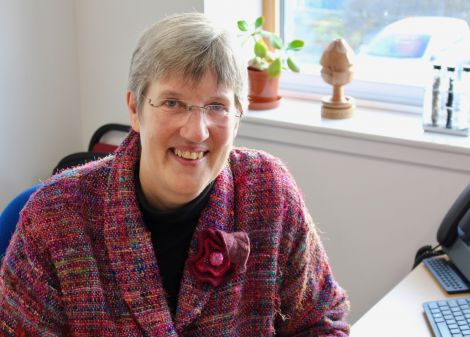Education / New college vows to ‘do a good job for Shetland’
THE MERGER of Shetland’s two further education colleges and Train Shetland into one new organisation, Shetland UHI, will offer tertiary education, commercial training and research in an “as effective as possible way”, according to the new college’s principal Jane Lewis.
Marking the start of a new era, the chair of the Shetland UHI board, Davie Sandison, added that the main change was in the governance of the organisation, which has become clearer and simpler; while staff would continue to do exactly the same job as before.
What started as a cost-cutting exercise around 10 years ago to ease some of the significant pressures on Shetland Islands Council’s finances, quickly became an ambition to “simplify the landscape” to offer enhanced and more varied education and training opportunities on the local level.
Following the official merger on Sunday (1 August) a restructuring process to streamline the three separate organisations into one is now underway.
This is expected to take a year and could see the loss of 14 jobs. Lewis said the hope was that all redundancies could be achieved voluntarily.
The new college with a combined staff of around 140, constituted as a limited but not-for-profit-company, will receive its core funding from the Scottish Funding Council (SFC).
It is independent from Shetland Islands Council and will no longer receive an annual subsidy in the region of £1 million, but will be able to apply to funding bodies, including the SIC, for financial assistance for specific educational and research projects.
Lewis dismissed concerns that by forming a new college education in the islands had been privatised, as suggested by the further education branch of the EIS union.
“We have very stringent governance arrangements, we will become assigned to the University of the Highlands and Islands; they are our regional strategic body,” she said.
Become a member of Shetland News
“The Scottish Funding Council look after the regional strategic bodies, so we report through to SFC just as all other colleges do; we are set up as a charitable company and we are here for the tertiary education of Shetland, we are not privatised in any way and we are not making money for any particular people.
“We are here to deliver a good job for Shetland,” she added.
Lewis continued by saying that some of the benefits of merging the colleges were already becoming a reality in the form of new apprenticeships for the emerging renewable energy sector.
“We are already bringing elements together and joining up the delivery of, for example, apprenticeships of the two colleges and Train Shetland,” she said.
“And what is probably most exciting is that we started talking about new curriculum developments, for example the [NAFC] engineers talking to [Shetland College] computer science people with a view of what we could now offer that we couldn’t before, particularly with the developments around renewables.”
Sandison said he was conscious of the ”very significant point” reached and added that launching the new college in the middle of the summer break with no students on campus felt somewhat “strange”.
He said there was no doubt that financially the new college had a challenge ahead of it but added that this applied to every college in the country.
“We will have to work hard on that particular element,” he said. “It is the one thing that I would still regard as challenging, but that goes for most colleges within the UHI, and in fact most colleges in the land, and it depends very much on the priorities of the government of the day.”
Meanwhile the property costs for the colleges in Scalloway and Lerwick have come down significantly after the council bought Shetland Leasing and Property Developments Limited (SLAP) from the Shetland Charitable Trust in October 2018.
“The lease arrangements that were in place have been dramatically changed over the last few years because the council bought SLAP, and SLAP were sitting on these rather over the top lease arrangements for certain assets,” Sandison said.
“Having taken control of SLAP, the council had then made changes to the lease arrangements (…) for the main buildings in Scalloway and the building in Lerwick. And that substantially reduced the cross-charge within the council for those leases.
“Having cut that out it means that operationally we certainly have a lower operating cost going ahead than we would have had otherwise.”
A spokesperson for the SIC said: “It is too soon to put an exact figure on the financial savings to Shetland Islands Council resulting from this merger but they are expected to be in the region of £1 million annually.
“The council expects to commission a range of services from Shetland UHI for both training and research, and to work in partnership with Shetland UHI on the Islands Deal and as a key stakeholder in the Shetland Partnership”.
The long-anticipated and now completed merger has also been welcomed by Shetland MSP Beatrice Wishart.
“As we prepare for life after Covid-19, with changes to how we learn and develop skills for the workforce in industries such as renewables and across the maritime and marine environment, the merger comes at a crucial time for Shetland’s economic development,” she said.
“There are strong foundations on which to build, learn and train at Scotland’s ‘top college’ with all the expertise of the three merged organisations. I wish Shetland UHI every success for the future.”
Earlier this month Wishart and fellow MSPs from Orkney and the Western Isles called on the Scottish Government to top up funding for island colleges to fix a financial shortfall.
Become a member of Shetland News
Shetland News is asking its many readers to consider paying for membership to get additional features and services: -
- Remove non-local ads;
- Bookmark posts to read later;
- Exclusive curated weekly newsletter;
- Hide membership messages;
- Comments open for discussion.
If you appreciate what we do and feel strongly about impartial local journalism, then please become a member of Shetland News by either making a single payment, or setting up a monthly, quarterly or yearly subscription.



















































































